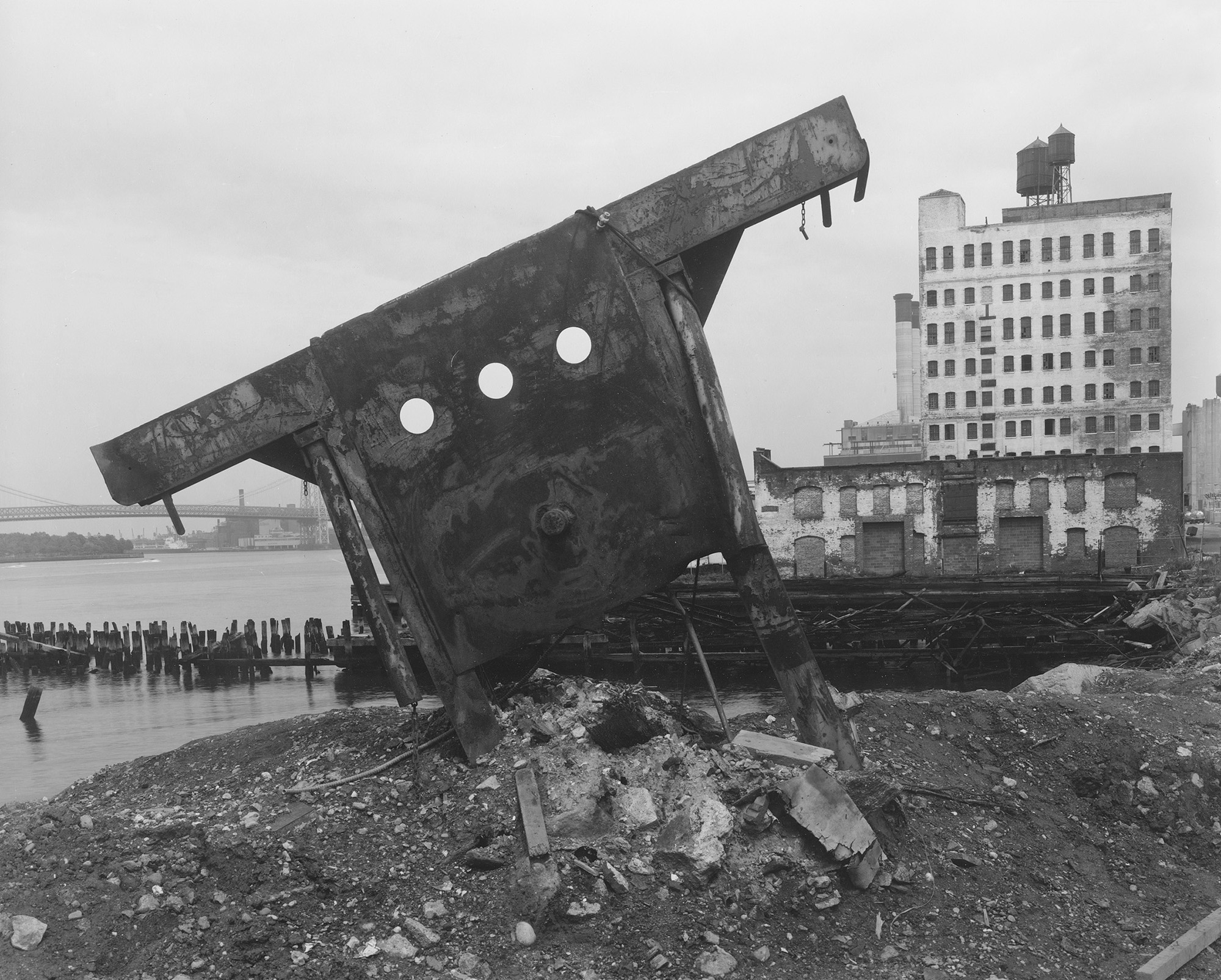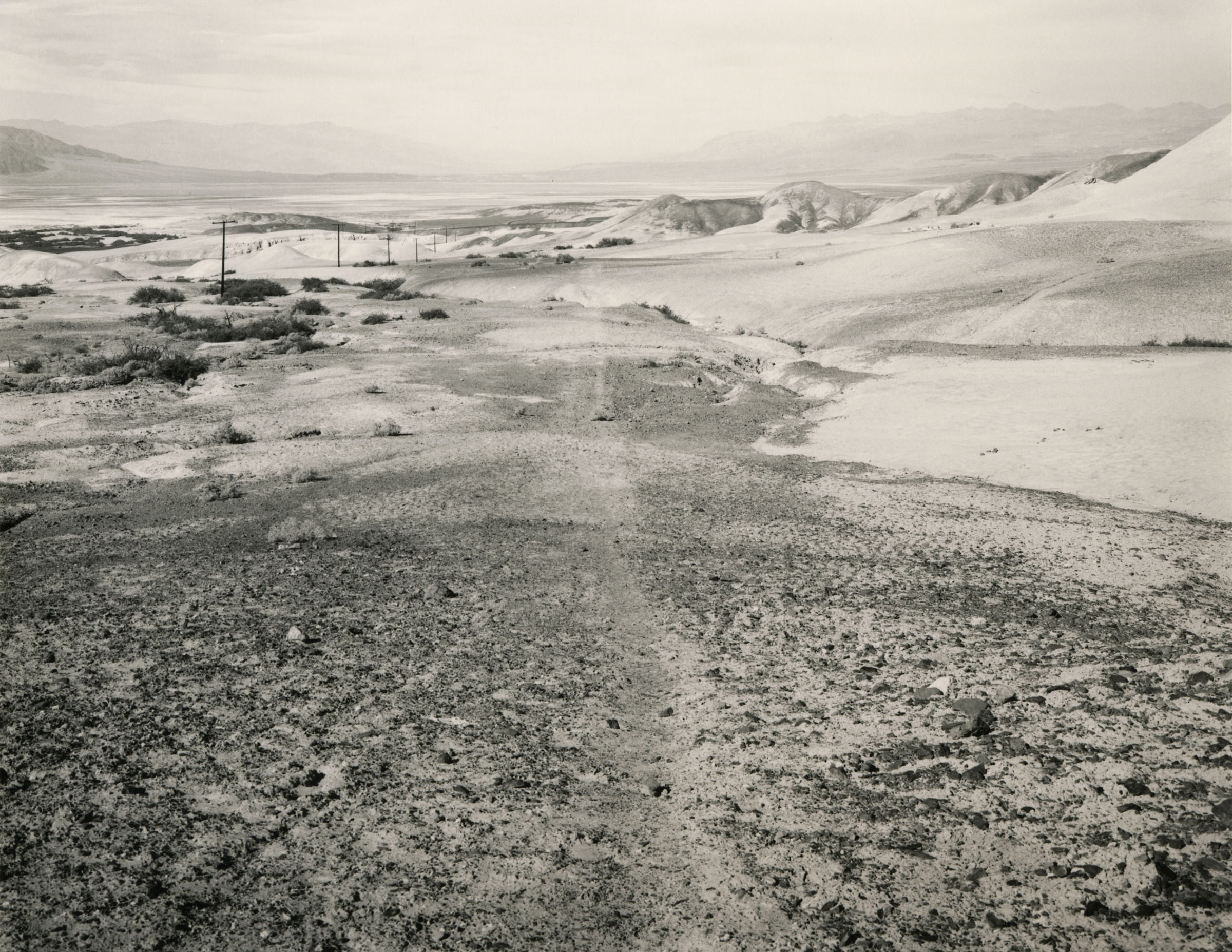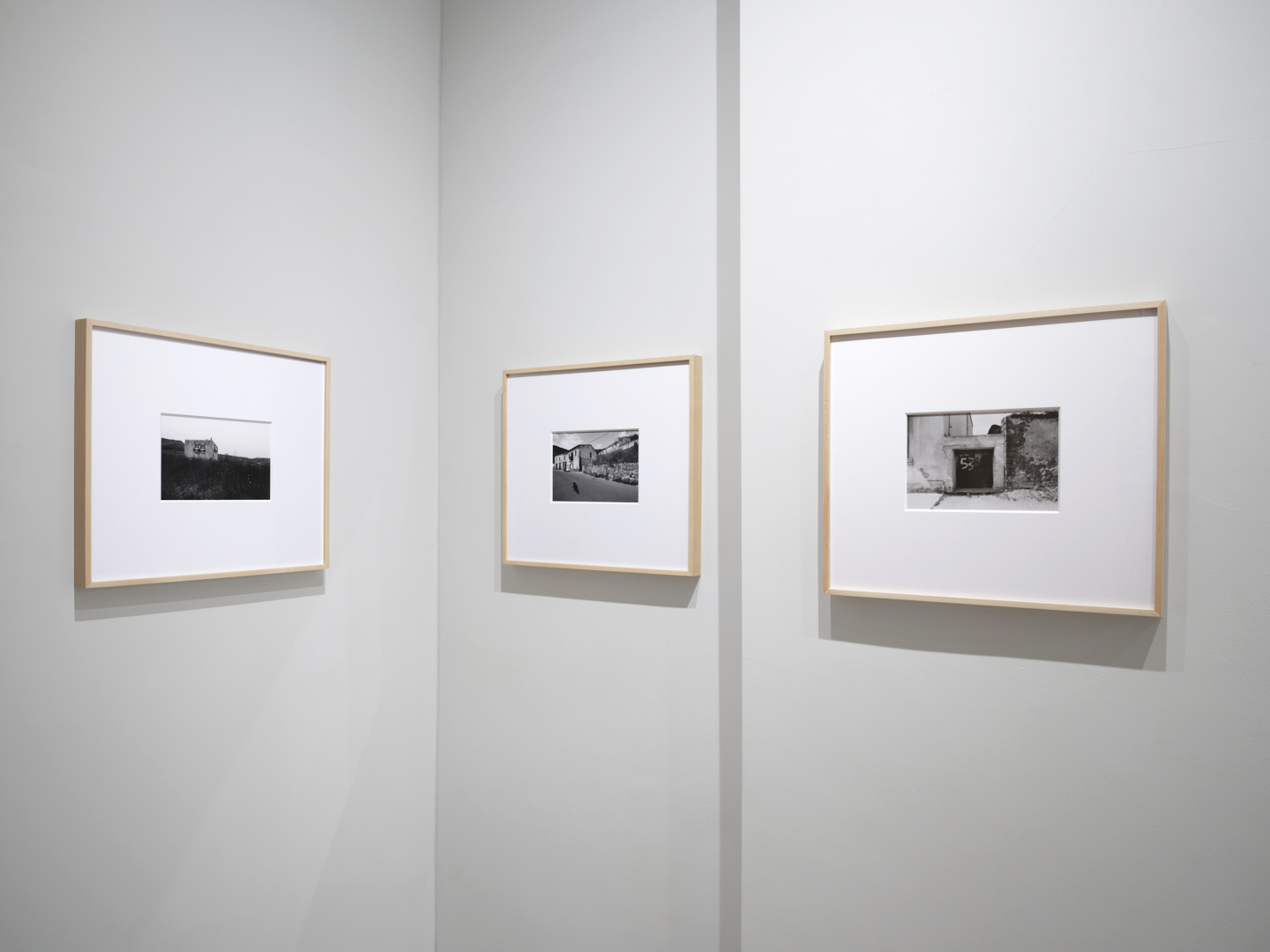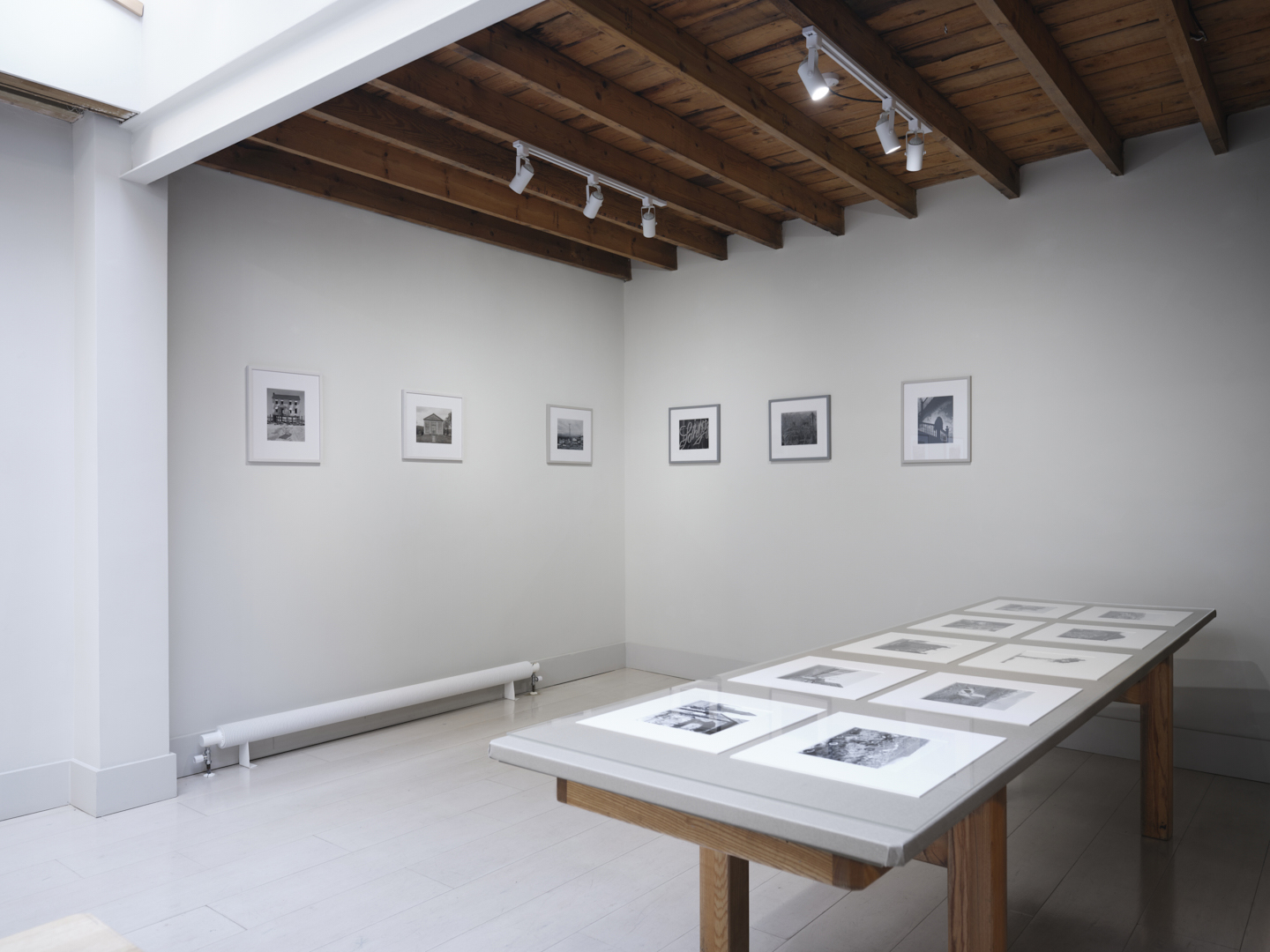
















Stepping Stones: Three Photographic Journeys
27 Sep—10 Nov 2023Extended to 30 Nov
Stepping Stones: Three Photographic Journeys connects the work of three photographers: Gerry Johansson, Guido Guidi and Mark Ruwedel. Focusing on a specific journey by each artist, three distinct conceptual, and personal, approaches to capturing place unfold – whether with a care for the overlooked, finding intimacy in one’s everyday surroundings, or surveying humankind’s effect on the landscape.
Gerry Johansson realised his series Motel Prints (1983) during a coast-to-coast long trip, beginning in Los Angeles in May 1983 and ending in New York, via Utah, Colorado, Oklahoma, and Arkansas to Memphis, meeting with renowned photographers of the time, Robert Adams, Richard Benson, Gary Winogrand and William Eggleston, among others. Taking photographs daily with his 8x10” camera, he would develop film in the evening in his motel rooms, making contact prints from select negatives by placing a glass plate on top of the printing paper and turning on the room light for a few seconds. This significant year of experimentation and artistic research across the US led Johansson to dedicate his career full-time to photography.
Central to Johansson’s presentation is a new portfolio, ‘Coast to Coast’, comprising 10 gelatin silver contact prints and an accompanying booklet produced by Imagebeeld Edition, Brussels. These images, shot in black and white, pay careful attention to the varying landscapes and architectures Johansson encountered on his journey. In an excerpt from the booklet, Johansson asks: ‘Did I learn anything during this process? Yes, I think so. For the first time, I was able to spend a lot of time photographing and evaluating my work. It is one thing to believe that you have taken some good photographs and something else to be confronted with lots of mistakes and bad choices and the occasional interesting picture.’
In May 1974, a newlywed Guido Guidi travelled to Sardinia with his wife Marta, instinctively capturing an unfamiliar landscape, shooting with his Nikon camera. While his peers were focused on portraiture, Guidi immortalised bollards, the backs of flaking houses, old gates, external doors, bushes and stones. As Irina Zucca Alessandrelli writes, Guidi’s ‘truth is anonymous and invisible to the eyes of the majority.’ And as with Johansson’s unconventional means of processing, Guidi also experimented with solarising his images, using lemon juice for instance to transform his black and white images into fluorescent colours, or using cardboard sheets with small holes in them to direct light onto certain parts of the print. As Antonello Frongia writes of the series:
‘Seen side by side, coupled by the black frame which joins them, these simple sequential snapshots look like impersonal records of a nine-teenth-century topographer, or like experiments in description, or even like two meditations on photography's genres and styles: elevation and cross section of a landscape, perspectival narration and formal reduction, reportage on the road and analytic abstraction.’
Mark Ruwedel describes his Ice Age series (1995-2003) as ‘a study of human activity in the context of the Pleistocene lakes which once covered large portions of the arid American West.’
It brings together photographs that record the evidence of both prehistoric and contemporary cultures within the landscape as well as the ways in which these settlements and activities have left visible marks on it. Ruwedel focused his camera on prehistoric trails, sleeping and ceremonial circles, and intaglios, all of which were shaped by the placement and displacement of stones in vast, open plains. As Ann Thomas writes:
‘Ruwedel's superb narrative about the land is a journey through time. It is about historical memory and geological evidence. It uses the essential human tools of the imagination and the making of inventories to situate us in a new relationship to our place and time. Unlike geological diagrams which fill in with hand drawn lines the missing information about separated continental plates or dried up inland seas, and direct our attention to particular areas of interest with arrows, Ruwedel's photographs challenge the human imagination to make the links between the past and the present independently.’
Throughout their journeys, walking as much in the footsteps of their predecessors as finding new pathways in photography, these three artists focus on the signs of a human presence, whether implied, evoked, or documented. Their distinct styles come together through their dedicated observations of the places they, and we, move through, looking closely and attentively to capture what is left behind, overlooked and unnoticed.
Stepping Stones: Three Photographic Journeys is co-curated by Jean-Paul Deridder.
Jean-Paul Deridder writes and teaches on art and photography at the Royal Academy of Fine Arts in Brussels. He was the co-founder and Director at Fondation A Stichting, Brussels from 2012 to 2020 where he curated numerous exhibitions including Judith Joy Ross, Mitch Epstein, Lewis Baltz, Bernd & Hilla Becher, Lee Friedlander, Jo Ratcliffe, Facundo de Zuviria, Guido Guidi, Paolo Gasparini and Nicholas Nixon. In 2022, he founded Imagebeeld Edition, a new publishing project of portfolios and books.
Gerry Johansson realised his series Motel Prints (1983) during a coast-to-coast long trip, beginning in Los Angeles in May 1983 and ending in New York, via Utah, Colorado, Oklahoma, and Arkansas to Memphis, meeting with renowned photographers of the time, Robert Adams, Richard Benson, Gary Winogrand and William Eggleston, among others. Taking photographs daily with his 8x10” camera, he would develop film in the evening in his motel rooms, making contact prints from select negatives by placing a glass plate on top of the printing paper and turning on the room light for a few seconds. This significant year of experimentation and artistic research across the US led Johansson to dedicate his career full-time to photography.
Central to Johansson’s presentation is a new portfolio, ‘Coast to Coast’, comprising 10 gelatin silver contact prints and an accompanying booklet produced by Imagebeeld Edition, Brussels. These images, shot in black and white, pay careful attention to the varying landscapes and architectures Johansson encountered on his journey. In an excerpt from the booklet, Johansson asks: ‘Did I learn anything during this process? Yes, I think so. For the first time, I was able to spend a lot of time photographing and evaluating my work. It is one thing to believe that you have taken some good photographs and something else to be confronted with lots of mistakes and bad choices and the occasional interesting picture.’
In May 1974, a newlywed Guido Guidi travelled to Sardinia with his wife Marta, instinctively capturing an unfamiliar landscape, shooting with his Nikon camera. While his peers were focused on portraiture, Guidi immortalised bollards, the backs of flaking houses, old gates, external doors, bushes and stones. As Irina Zucca Alessandrelli writes, Guidi’s ‘truth is anonymous and invisible to the eyes of the majority.’ And as with Johansson’s unconventional means of processing, Guidi also experimented with solarising his images, using lemon juice for instance to transform his black and white images into fluorescent colours, or using cardboard sheets with small holes in them to direct light onto certain parts of the print. As Antonello Frongia writes of the series:
‘Seen side by side, coupled by the black frame which joins them, these simple sequential snapshots look like impersonal records of a nine-teenth-century topographer, or like experiments in description, or even like two meditations on photography's genres and styles: elevation and cross section of a landscape, perspectival narration and formal reduction, reportage on the road and analytic abstraction.’
Mark Ruwedel describes his Ice Age series (1995-2003) as ‘a study of human activity in the context of the Pleistocene lakes which once covered large portions of the arid American West.’
It brings together photographs that record the evidence of both prehistoric and contemporary cultures within the landscape as well as the ways in which these settlements and activities have left visible marks on it. Ruwedel focused his camera on prehistoric trails, sleeping and ceremonial circles, and intaglios, all of which were shaped by the placement and displacement of stones in vast, open plains. As Ann Thomas writes:
‘Ruwedel's superb narrative about the land is a journey through time. It is about historical memory and geological evidence. It uses the essential human tools of the imagination and the making of inventories to situate us in a new relationship to our place and time. Unlike geological diagrams which fill in with hand drawn lines the missing information about separated continental plates or dried up inland seas, and direct our attention to particular areas of interest with arrows, Ruwedel's photographs challenge the human imagination to make the links between the past and the present independently.’
Throughout their journeys, walking as much in the footsteps of their predecessors as finding new pathways in photography, these three artists focus on the signs of a human presence, whether implied, evoked, or documented. Their distinct styles come together through their dedicated observations of the places they, and we, move through, looking closely and attentively to capture what is left behind, overlooked and unnoticed.
Stepping Stones: Three Photographic Journeys is co-curated by Jean-Paul Deridder.
Jean-Paul Deridder writes and teaches on art and photography at the Royal Academy of Fine Arts in Brussels. He was the co-founder and Director at Fondation A Stichting, Brussels from 2012 to 2020 where he curated numerous exhibitions including Judith Joy Ross, Mitch Epstein, Lewis Baltz, Bernd & Hilla Becher, Lee Friedlander, Jo Ratcliffe, Facundo de Zuviria, Guido Guidi, Paolo Gasparini and Nicholas Nixon. In 2022, he founded Imagebeeld Edition, a new publishing project of portfolios and books.
Gerry Johansson, Guido Guidi, Mark Ruwedel
Enquiries
press: Rose Gleadell
sales: Charlotte Schepke
other: Large Glass
portfolio: Imagebeeld Edition
Enquiries
press: Rose Gleadell
sales: Charlotte Schepke
other: Large Glass
portfolio: Imagebeeld Edition